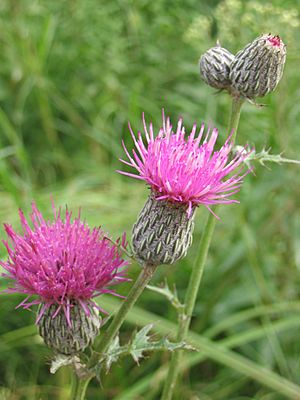Swamp thistle facts for kids
Quick facts for kids Swamp thistle |
|
|---|---|
 |
|
| Scientific classification | |
| Genus: |
Cirsium
|
| Species: |
muticum
|
The swamp thistle (Cirsium muticum) is a plant found in North America. It is also known as marsh thistle, dunce-nettle, or horsetops. This plant belongs to the sunflower family. You can find it growing naturally across central and eastern Canada and the central and eastern United States.
Contents
What Does the Swamp Thistle Look Like?
The swamp thistle is a plant that lives for two years. In its first year, it grows leaves close to the ground. In its second year, it grows a tall stem, flowers, and seeds before it dies. This plant can grow quite tall, sometimes reaching up to 180 centimeters (about 6 feet).
It has a thick main root that stores food. Its stem has ridges and tiny hairs, especially near the bottom. The leaves grow in an alternating pattern along the stem. They are deeply cut into lobes, like a feather, and have an oval shape. The leaf lobes are often uneven and branch out in an irregular way. The corners of these lobes have very fine, tiny hairs called trichomes. As you go up the stem, the leaves get smaller. The underside of the leaves might also have a few of these tiny hairs.
The flower stalks are short, usually between 0 and 15 centimeters long. Each stalk holds a flower head made up of many small flowers called florets. The protective leaves around the flower head, called the involucre, are covered in white, cobweb-like hairs and can feel a bit sticky. The florets themselves are purple and can be up to 27 millimeters long.
Where Does the Swamp Thistle Grow?
The swamp thistle grows in many places across Canada. You can find it in every province, from Labrador and Newfoundland all the way to Saskatchewan. In the United States, it mostly grows in the Northeast, around the Great Lakes region, and in the Appalachian Mountains. You might also find some scattered groups of these plants in the South, from Texas to the Carolinas.
This plant prefers wet places. It often grows in swamps, wetlands, marshes, and low forests. Some types of swamp thistle can even grow in wet, high-altitude areas like alpine climates.
How Does the Swamp Thistle Interact with Other Living Things?
The swamp thistle is an important plant for many insects and birds. It acts as a host plant for some types of butterflies and moths. For example, the swamp metalmark butterfly (Calephelis muticum) relies on this thistle. The female butterfly lays her eggs on the swamp thistle. When the eggs hatch, the caterpillars eat only the flowers of the swamp thistle to grow.
The swamp thistle is also a host plant for the caterpillars of the painted lady butterfly. In addition, many songbirds enjoy eating the seeds of the swamp thistle.
Other plants that often grow near the swamp thistle include:
- Flat-topped white aster (Aster umbellatus)
- Rough-leaved goldenrod (Solidago patula)
- Prairie loosestrife (Lysimachia quadrifolia)
- Smaller fringed gentian (Gentiana procera)
Why Is the Swamp Thistle Important to People?
People sometimes use swamp thistles to create beautiful flower arrangements. They are also planted in gardens because they are easier to manage than some other types of thistles. They might even help keep some plant-eating animals away from other garden plants.
Is the Swamp Thistle Endangered?
Overall, the swamp thistle is not considered endangered in Canada or the U.S. However, it is facing threats in some specific areas. For example, it is listed as threatened in the state of Arkansas. It is also considered vulnerable in the province of Saskatchewan.
The main reason the swamp thistle is at risk in these areas is because it is a wetland plant. Over the last 200 years, many wetlands in North America have been drained or destroyed. This loss of habitat makes it harder for the swamp thistle to survive in certain regions.

